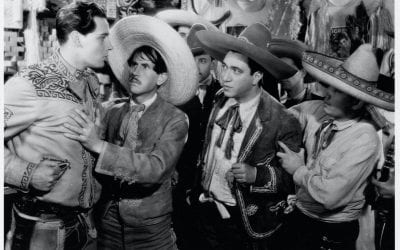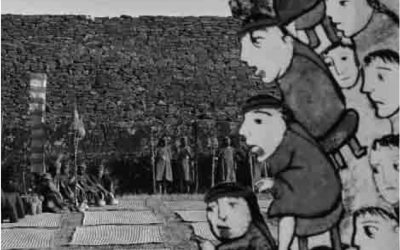Manifest Destinies and Indigenous Peoples
Contesting Civilization’s Destiny
This book is a tribute to the work of David Maybury-Lewis, the late and distinguished Professor Emeritus at Harvard’s Department of Anthropology, where I had the honor to be his student and advisee. It is his last book and a continuation of his life’s work: the examination of another aspect of what governments have long called “the Indian question,” a topic to which Maybury-Lewis dedicated himself from both an academic and an applied perspective.
The book provides a comparative analysis of policies in the United States, Canada, Argentina, Brazil, and Chile in the second half of the nineteenth century to legitimize state expansion into territory inhabited by indigenous peoples within their national boundaries.
Four chapters concern the United States and Canada and the other three deal with South America. Theodore Macdonald’s introduction summarizes the authors’ central concerns and debates, while an afterword by Professor Maybury-Lewis’s son, Biorn Maybury-Lewis, discusses the life of his father not only as a respected academic but also as an intellectual committed to the welfare of indigenous peoples. These dual commitments date back to Dr. Maybury-Lewis’s eighteen months of intensive fieldwork with the Xavante people of Brazil in the late 1950s, which his son Biorn also experienced as a toddler.
The book’s historical perspective and its emphasis on North America allow us to explore another question beyond its own primary concern: the means by which the United States was constructed as a nation whose “destiny” was to bring civilization not only to the lands within its own borders, but beyond them as well, thus legitimizing its role as an expanding empire and producing the national imaginary that has lasted to this day. In this vein, the chapter by Richard White discusses the rise of U.S. corporations beginning in the mid-19th century and the extent to which state and corporate activities would result in the separation of indigenous peoples from their lands in the name of development.
In his chapter, Anders Stephanson explores the ideological content of the idea of Manifest Destiny, a catchphrase coined by John O’ Sullivan in 1840 according to which the United States was “the nation of human progress” and no person or thing could constrain it in this, its intrinsic mission (p. 25). Stephanson indicates that “the massive expansionist moves of the 1840s entailed a much more centered politics of ‘destiny,’” and that “destinarianism (to coin a phrase) became the very idiom of the whole project of expansion” (p. 26). The mission of the United States was to propagate democracy on the North American continent, and its ultimate goal was to liberate humanity.
Stephanson shows how these ideas inform the actions taken in the conquest of the national territory “conceived not as war but as ´pacification´” (p.33) that were directed toward the western territories of the United States in order to promote freedom, eliminate wilderness, and institute a private property regime as a symbol of national independence and a means to make the land productive. This was justifiable since Native Americans were represented as lacking any conception of property and unable to produce beyond the level of subsistence. Thus they had no intrinsic right to the land.
All of the chapters refer to the existence of internal frontiers or the relation between the center and the periphery of states. These relations correspond to a contrast between what is considered civilized and savage. Frontier areas are represented as places where barbarity reigns, places that by rights should be integrated into the nation as represented by the center, where development takes place and from which the modern civilized nation is constructed and the politics of destiny are implemented. The differences among the countries discussed refer to the origin and nature of policies and the actions to be taken, in keeping with each nation’s self-image and representation. The elucidation of these differences is the most important contribution of the book.
Anders Stephanson, Edward Chamberlain and Roger L. Nichols contrast English relations with indigenous peoples in their direct colonial possessions with the indigenous policies of the colonies’ successor governments. All three authors highlight indigenous policies in Canada that continued the English “protectionist” approach followed since 1670, based on the premise that the newcomers should deal justly with the Indians, learn their languages, and protect their territories and possessions (p. 175).
Nichols points out that by 1877, “while American authorities treated tribal peoples as enemies or at least obstacles to national growth and development, early Canadian leaders considered First Nations people as military and diplomatic allies” (p. 151). At the end of the nineteenth century Canadian and U.S. policies grew steadily more similar, and by the beginning of the 20th century their common pursuit of advanced civilization, progress, and the construction of homogeneous nation-states justified to their governments the goal of eliminating the indigenous peoples, now seen as obstacles to meeting those objectives.
In Argentina, Brazil, and Chile (and unlike in Canada and the United States), the representation of areas in the interior of the country as “empty” and the consequent invisiblization of indigenous peoples living there were used to legitimize policies for the conquest of these internal frontiers. These policies entailed active attacks, Iberian-style crusades, and the promotion of colonization by foreign immigrant populations.
In the case of Argentina, the pursuit of order, progress, and civilization took on dramatic dimensions. For example, General Julio Argentino Roca led a series of military campaigns between 1878 and 1885 collectively known as the “Conquest of the Desert,” seeking to annex the Indian territories of La Pampa and Patagonia. Claudia Briones and Walter Delirio argue that this policy was designed to transform La Pampa and Patagonia “into a sociological ‘desert’ through de-tribalization and practical extermination that extended well beyond the period of military campaigns” (p. 52). This approach freed Argentina from having to develop a policy for the incorporation of the indigenous peoples of Patagonia into the nation-state. It implicitly promoted the colonization of this “empty desert region,” arguing that the Mapuches who were living there were not only savages, but invaders from neighboring Chile who should be expelled, if not exterminated. Briones and Delirio conclude that to the Argentine government, the task of governing the national territory included populating these empty spaces. This was seen as “a vital constituent of the national Project and Destiny.” Unlike the U.S. idea of expanding into new territories, the Argentineans spoke of recovering territory.
As the 20th century neared its end, the results of these de-Indianization and extermination policies allowed Argentina to define itself as having either no Indians or perhaps only a few remnant groups. The authors present testimony from elderly representatives of indigenous groups who describe their silent resistance in the face of continuous assaults. Although Mapuches have lived in the country for generations, their rights began to be recognized only with the constitutional reforms of 1994, and their authenticity as natives continues to be debated.
In his chapter, José Bengoa describes Chile as a country at the southern end of the American landmass whose center is contrasted with the unconquerable south. Just as Argentina embarked on a Conquest of the Desert, the Chilean military launched a campaign for the “Pacification of Araucania (Mapuche Territory),” a period of intense military activity between 1866 and 1881, breaking a peace treaty between the Mapuche and the Marquis de Baydes reached in 1641 after a major uprising in 1598. This treaty gave the Mapuche the right to self-government, and although their culture had flourished with the incorporation of foreign elements such as the use of horses, people at the center imagined the south as largely uninhabited, with only a few small indigenous groups on the verge of extinction. During the 19th century Chilean expansion toward its northern and southern borders was seen as a civilizing process entailing the Chileanization of the Aymaras in the north and the extermination of the indigenous peoples of the south. Although Chile counted 101,118 Araucanos or Mapuches in its territory in 1907, Bengoa asserts that like Argentina, Chile sought to “whiten” itself after its independence in 1810. A European-American national image was constructed and between 1881 and 1927 the indigenous population was restricted to reservations established after Pacification.
This practice of indigenous relocation and geographical restriction is also analyzed. In the case of United States, thousands of people from almost all the eastern tribes were relocated, while in Canada relocation affected only a few small bands (p. 158). In addition to relocating the native inhabitants, in the middle of the nineteenth century the Chilean government organized the colonization of its “empty” southern territories by German settlers, promoted as representatives of European civilization whose presence would benefit the nation. Bengoa concludes with the affirmation that “Chile has united its national territory and thus “fulfilled its destiny” to reach the fabled south but has done so by suppressing the indigenous peoples in the south, and has thus created a conflict that lasts to this day” (p. 138).
In the case of Brazil, João Pacheco de Oliveira discusses the contrast between the coastal areas and Amazonia, which was also represented as an empty territory or a territory inhabited only by savages where both the natural environment (a green hell) and its inhabitants needed to be domesticated in order for wealth to be produced. During the colonial period there was much talk of conquering the Amazon jungle. Evangelization of the savages by missionaries played a central role in their subordination to the colonial regime. Those who resisted were considered legitimate military targets in what was deemed a just war to integrate them into the nation. Pacheco de Oliveira discusses the Brazilian imaginary in which “wild Indians” are said to be “the true and ancient lords of the land [constituting] indisputable proof of the existence of Brazil before the arrival of the Portuguese,” and “the oldest and most authentic symbols of Brazilian nationalism” (p. 100). He evaluates the contradiction in which indigenous Brazilians of the past were portrayed as noble savages while contemporaneous Amazonian Indians have in practice been represented as a “residual humanity that was headed towards inevitable extinction” (pg.102). This kind of tension between government discourse and policy recurs in every chapter. Nonetheless, at the dawn of the 20th century the idea of incorporating savage and unbaptized Indians into the nation gained favor and the state took an ever-more tutelary and protective approach, considering the natives primitive beings who did not know or understand the white man and his ways. As a result, the levels of violence unleashed against Indians diminished, with the exception of the Argentine persecution and elimination of the Mapuches, justified by their stigmatization as foreign invaders.
This book and its role in presenting the work of international scholars on indigenous peoples in the construction of the nation-state in the Americas is a fitting tribute to our late Professor Emeritus David-Maybury-Lewis who fought to make visible the indigenous groups in the Americas, defending their rights and protecting their lands languages and cultures, aiming to to stop the cultural devastation so thoroughly examined in this book.
Fall 2009, Volume VIII, Number 3
María Clemencia Ramírez is Research Associate and former Director of the Colombian Institute of Anthropology and History. She holds a Ph.D. in Social Anthropology from Harvard University and was the 2004-2005 Santo Domingo Visiting Scholar at Harvard’s David Rockefeller Center for Latin American Studies. She is a Fellow of the John Simon Guggenheim Memorial Foundation for the year 2009-2010.
Related Articles
Oscars for Mexican Filmmakers
English + Español
A couple of years ago, in 2007, the so-called Three Amigos (the filmmakers Alfonso Cuarón, Guillermo del Toro and Alejandro González Iñárritu) went up on stage for the 79th Oscar Awards presentations. Their three films (Children of Men, Pan’s Labyrinth and Babel, respectively)/Hace poco tiempo, en el año 2007, los llamados Three Amigos (los cinerealizadores mexicanos Alfonso Cuarón, Guillermo del Toro y Alejandro González Iñárritu) subieron al escenario de la 79ª premiación del Óscar. En total, sus tres películas (Children of Men, Pan’s Labyrinth y Babel, respectivamente)…
Mexico’s National Museum of Film
Mexico has a long history of filmmaking, from the silent era to the present, with some particularly prolific periods that have been stimulated by state sponsorship and international recognition. Appreciation of the results began in the 1940s, when Mexican films won prizes at…
Eréndira Ikikunari
Hucha mítetixapquia escacsi hupiringa, máteru cuiripuecha. Atahpiticha encacsi tyámu xucuparhapca ca engacsi cacapequa úquaaca imaechani engancsi cuahpequarhenga. Ma cuiripuhcu no cherheaspti. Yurhistsquiri ma enga naneni, hamemquia Eréndira arhicurhispti…




